Как и в предыдущих версиях, Android 15 включает изменения в поведении, которые могут повлиять на ваше приложение. Следующие изменения в поведении применяются исключительно к приложениям, предназначенным для Android 15 и более поздних версий. Если ваше приложение предназначено для Android 15 и более поздних версий, вам следует изменить его для корректной поддержки этих изменений, где это применимо.
Обязательно ознакомьтесь со списком изменений поведения, которые влияют на все приложения, работающие на Android 15, независимо от targetSdkVersion вашего приложения.
Основная функциональность
Android 15 изменяет или расширяет различные основные возможности системы Android.
Изменения в приоритетных службах
Мы вносим следующие изменения в службы переднего плана в Android 15.
- Поведение времени ожидания службы синхронизации данных на переднем плане
- Новый тип приоритетной службы обработки мультимедиа
- Ограничения на широковещательные приемники
BOOT_COMPLETED, запускающие службы приоритета - Ограничения на запуск служб переднего плана, пока приложение имеет разрешение
SYSTEM_ALERT_WINDOW
Поведение тайм-аута службы синхронизации данных на переднем плане
В Android 15 представлен новый режим тайм-аута для dataSync для приложений, предназначенных для Android 15 (уровень API 35) или выше. Это поведение также применимо к новому типу службы переднего плана mediaProcessing .
Система разрешает службам dataSync приложения работать в общей сложности 6 часов в течение 24-часового периода, после чего система вызывает метод Service.onTimeout(int, int) работающей службы (представленный в Android 15). В это время у службы есть несколько секунд для вызова Service.stopSelf() . При вызове Service.onTimeout() служба больше не считается службой переднего плана. Если служба не вызывает Service.stopSelf() , система выдает внутреннее исключение. Исключение регистрируется в Logcat со следующим сообщением:
Fatal Exception: android.app.RemoteServiceException: "A foreground service of
type dataSync did not stop within its timeout: [component name]"
Чтобы избежать проблем с этим изменением поведения, вы можете выполнить одно или несколько из следующих действий:
- Пусть ваш сервис реализует новый метод
Service.onTimeout(int, int). Когда ваше приложение получит обратный вызов, обязательно вызовитеstopSelf()в течение нескольких секунд. (Если вы не остановите приложение сразу, система выдаст ошибку.) - Убедитесь, что службы
dataSyncвашего приложения не работают более 6 часов в течение 24-часового периода (если только пользователь не взаимодействует с приложением, сбрасывая таймер). - Запускайте службы
dataSyncпереднего плана только в результате прямого взаимодействия с пользователем; поскольку ваше приложение находится на переднем плане при запуске службы, у вашей службы есть полные шесть часов после того, как приложение перейдет в фоновый режим. - Вместо использования службы переднего плана
dataSyncиспользуйте альтернативный API .
Если службы приоритетного плана dataSync вашего приложения работали в течение 6 часов за последние 24 часа, вы не сможете запустить другую службу приоритетного плана dataSync , пока пользователь не переведет ваше приложение на передний план (что сбрасывает таймер). Если вы попытаетесь запустить другую службу переднего плана dataSync , система выдаст исключение ForegroundServiceStartNotAllowedException с сообщением об ошибке, например «Ограничение времени для типа службы переднего плана dataSync уже исчерпано».
Тестирование
Чтобы проверить поведение вашего приложения, вы можете включить таймауты синхронизации данных, даже если ваше приложение не предназначено для Android 15 (при условии, что приложение работает на устройстве Android 15). Чтобы включить таймауты, выполните следующую команду adb :
adb shell am compat enable FGS_INTRODUCE_TIME_LIMITS your-package-name
Вы также можете настроить период ожидания, чтобы было проще протестировать поведение вашего приложения при достижении предела. Чтобы установить новый период ожидания, выполните следующую команду adb :
adb shell device_config put activity_manager data_sync_fgs_timeout_duration duration-in-milliseconds
Новый тип приоритетной службы обработки мультимедиа
В Android 15 представлен новый тип службы переднего плана — mediaProcessing . Этот тип службы подходит для таких операций, как перекодирование медиафайлов. Например, мультимедийное приложение может загрузить аудиофайл, и ему необходимо преобразовать его в другой формат перед воспроизведением. Вы можете использовать службу переднего плана mediaProcessing чтобы гарантировать, что преобразование продолжается, даже когда приложение находится в фоновом режиме.
Система разрешает службам mediaProcessing приложения работать в общей сложности 6 часов в течение 24-часового периода, после чего система вызывает метод Service.onTimeout(int, int) работающей службы (представленный в Android 15). В это время у службы есть несколько секунд для вызова Service.stopSelf() . Если служба не вызывает Service.stopSelf() , система выдает внутреннее исключение. Исключение регистрируется в Logcat со следующим сообщением:
Fatal Exception: android.app.RemoteServiceException: "A foreground service of
type mediaProcessing did not stop within its timeout: [component name]"
Чтобы избежать исключения, вы можете сделать одно из следующих действий:
- Пусть ваш сервис реализует новый метод
Service.onTimeout(int, int). Когда ваше приложение получит обратный вызов, обязательно вызовитеstopSelf()в течение нескольких секунд. (Если вы не остановите приложение сразу, система выдаст ошибку.) - Убедитесь, что службы
mediaProcessingвашего приложения не работают более 6 часов в течение любого 24-часового периода (если только пользователь не взаимодействует с приложением, сбрасывая таймер). - Запускайте службы переднего плана
mediaProcessingтолько в результате прямого взаимодействия с пользователем; поскольку ваше приложение находится на переднем плане при запуске службы, у вашей службы есть полные шесть часов после того, как приложение перейдет в фоновый режим. - Вместо использования службы переднего плана
mediaProcessingиспользуйте альтернативный API , например WorkManager.
Если службы переднего плана mediaProcessing вашего приложения работали в течение 6 часов за последние 24, вы не сможете запустить другую службу переднего плана mediaProcessing , пока пользователь не переведет ваше приложение на передний план (что сбрасывает таймер). Если вы попытаетесь запустить другую службу переднего плана mediaProcessing , система выдаст ForegroundServiceStartNotAllowedException с сообщением об ошибке, например «Ограничение времени уже исчерпано для типа службы переднего плана mediaProcessing».
Дополнительные сведения о типе службы mediaProcessing см. в разделе Изменения в типах служб переднего плана для Android 15: обработка мультимедиа .
Тестирование
Чтобы проверить поведение вашего приложения, вы можете включить тайм-ауты обработки мультимедиа, даже если ваше приложение не предназначено для Android 15 (при условии, что приложение работает на устройстве Android 15). Чтобы включить таймауты, выполните следующую команду adb :
adb shell am compat enable FGS_INTRODUCE_TIME_LIMITS your-package-name
Вы также можете настроить период ожидания, чтобы было проще протестировать поведение вашего приложения при достижении предела. Чтобы установить новый период ожидания, выполните следующую команду adb :
adb shell device_config put activity_manager media_processing_fgs_timeout_duration duration-in-milliseconds
Ограничения на широковещательные приемники BOOT_COMPLETED , запускающие службы приоритета
Существуют новые ограничения на широковещательные приемники BOOT_COMPLETED , запускающие службы приоритета. Получателям BOOT_COMPLETED не разрешено запускать следующие типы служб приоритета:
-
dataSync -
camera -
mediaPlayback -
phoneCall -
mediaProjection -
microphone(это ограничение действует дляmicrophoneначиная с Android 14)
Если получатель BOOT_COMPLETED пытается запустить любой из этих типов служб переднего плана, система выдает исключение ForegroundServiceStartNotAllowedException .
Тестирование
Чтобы проверить поведение вашего приложения, вы можете включить эти новые ограничения, даже если ваше приложение не предназначено для Android 15 (при условии, что приложение работает на устройстве Android 15). Запустите следующую команду adb :
adb shell am compat enable FGS_BOOT_COMPLETED_RESTRICTIONS your-package-name
Чтобы отправить широковещательную рассылку BOOT_COMPLETED без перезагрузки устройства, выполните следующую команду adb :
adb shell am broadcast -a android.intent.action.BOOT_COMPLETED your-package-name
Ограничения на запуск служб переднего плана, пока приложение имеет разрешение SYSTEM_ALERT_WINDOW
Раньше, если приложение имело разрешение SYSTEM_ALERT_WINDOW , оно могло запустить службу переднего плана, даже если приложение в данный момент находилось в фоновом режиме (как обсуждалось в разделе об исключениях из ограничений фонового запуска ).
Если приложение предназначено для Android 15, это исключение теперь уже. Теперь приложению необходимо иметь разрешение SYSTEM_ALERT_WINDOW , а также иметь видимое окно наложения. То есть приложению необходимо сначала запустить окно TYPE_APPLICATION_OVERLAY , и это окно должно быть видимым перед запуском службы переднего плана.
Если ваше приложение пытается запустить службу переднего плана в фоновом режиме, не отвечая этим новым требованиям (и у него нет других исключений), система выдает ForegroundServiceStartNotAllowedException .
Если ваше приложение объявляет разрешение SYSTEM_ALERT_WINDOW и запускает службы переднего плана в фоновом режиме, это изменение может повлиять на него. Если ваше приложение получает исключение ForegroundServiceStartNotAllowedException , проверьте порядок операций вашего приложения и убедитесь, что в нем уже есть активное окно наложения, прежде чем оно попытается запустить службу переднего плана из фона. Вы можете проверить, видимо ли ваше окно наложения в данный момент, вызвав View.getWindowVisibility() , или вы можете переопределить View.onWindowVisibilityChanged() чтобы получать уведомления при каждом изменении видимости.
Тестирование
Чтобы проверить поведение вашего приложения, вы можете включить эти новые ограничения, даже если ваше приложение не предназначено для Android 15 (при условии, что приложение работает на устройстве Android 15). Чтобы включить эти новые ограничения на запуск служб переднего плана в фоновом режиме, выполните следующую команду adb :
adb shell am compat enable FGS_SAW_RESTRICTIONS your-package-name
Изменения в том, когда приложения могут изменять глобальное состояние режима «Не беспокоить»
Приложения, предназначенные для Android 15 (уровень API 35) и выше, больше не могут изменять глобальное состояние или политику режима «Не беспокоить» (DND) на устройстве (путем изменения пользовательских настроек или отключения режима «Не беспокоить»). Вместо этого приложения должны внести AutomaticZenRule , которое система объединяет в глобальную политику с существующей схемой наиболее ограничительной политики. Вызовы к существующим API, которые ранее влияли на глобальное состояние ( setInterruptionFilter , setNotificationPolicy ), приводят к созданию или обновлению неявного AutomaticZenRule , который включается и выключается в зависимости от цикла вызовов этих вызовов API.
Обратите внимание, что это изменение влияет на наблюдаемое поведение только в том случае, если приложение вызывает setInterruptionFilter(INTERRUPTION_FILTER_ALL) и ожидает, что этот вызов деактивирует AutomaticZenRule , который ранее был активирован его владельцами.
Изменения API OpenJDK
Android 15 продолжает работу по обновлению основных библиотек Android для приведения их в соответствие с функциями последних выпусков OpenJDK LTS.
Некоторые из этих изменений могут повлиять на совместимость приложений для Android 15 (уровень API 35):
Изменения в API форматирования строк : Проверка индекса аргумента, флагов, ширины и точности теперь более строгая при использовании следующих API
String.format()иFormatter.format():-
String.format(String, Object[]) -
String.format(Locale, String, Object[]) -
Formatter.format(String, Object[]) -
Formatter.format(Locale, String, Object[])
Например, следующее исключение возникает при использовании индекса аргумента 0 (
%0в строке формата):IllegalFormatArgumentIndexException: Illegal format argument index = 0В этом случае проблему можно устранить, используя индекс аргумента 1 (
%1в строке формата).-
Изменения в типе компонента
Arrays.asList(...).toArray(): при использованииArrays.asList(...).toArray()тип компонента результирующего массива теперь являетсяObject, а не типом элементов базового массива. Поэтому следующий код вызывает исключениеClassCastException:String[] elements = (String[]) Arrays.asList("one", "two").toArray();В этом случае, чтобы сохранить
Stringкак тип компонента в результирующем массиве, можно вместо этого использоватьCollection.toArray(Object[]):String[] elements = Arrays.asList("two", "one").toArray(new String[0]);Изменения в обработке языковых кодов : при использовании
LocaleAPI языковые коды иврита, идиша и индонезийского языка больше не преобразуются в устаревшие формы (иврит:iw, идиш:jiи индонезийский:in). При указании языкового кода для одной из этих локалей вместо этого используйте коды из ISO 639-1 (иврит:he, идиш:yiи индонезийский:id).Изменения в случайных последовательностях целых чисел : после изменений, внесенных в https://bugs.openjdk.org/browse/JDK-8301574 , следующие методы
Random.ints()теперь возвращают другую последовательность чисел, чем методыRandom.nextInt():Как правило, это изменение не должно приводить к нарушению работы приложения, но ваш код не должен ожидать, что последовательность, сгенерированная методами
Random.ints()будет соответствоватьRandom.nextInt().
Новый API SequencedCollection может повлиять на совместимость вашего приложения после обновления compileSdk в конфигурации сборки вашего приложения для использования Android 15 (уровень API 35) :
Столкновение с функциями расширения
MutableList.removeFirst()иMutableList.removeLast()вkotlin-stdlibТип
Listв Java сопоставлен с типомMutableListв Kotlin. Поскольку APIList.removeFirst()иList.removeLast()появились в Android 15 (уровень API 35), компилятор Kotlin статически разрешает вызовы функций, например,list.removeFirst(), в новые APIList, а не в функции расширения изkotlin-stdlib.Если приложение перекомпилировано с
compileSdkустановленным на35, иminSdkустановленным на34или ниже, а затем запущено на Android 14 и ниже, возникает ошибка времени выполнения:java.lang.NoSuchMethodError: No virtual method removeFirst()Ljava/lang/Object; in class Ljava/util/ArrayList;Существующая опция lint
NewApiв плагине Android Gradle может отследить эти новые случаи использования API../gradlew lintMainActivity.kt:41: Error: Call requires API level 35 (current min is 34): java.util.List#removeFirst [NewApi] list.removeFirst()Чтобы исправить исключение времени выполнения и ошибки линтинга, вызовы функций
removeFirst()иremoveLast()в Kotlin можно заменить наremoveAt(0)иremoveAt(list.lastIndex)соответственно. Если вы используете Android Studio Ladybug | 2024.1.3 или более позднюю версию, она также предоставляет возможность быстрого исправления этих ошибок.Рассмотрите возможность удаления
@SuppressLint("NewApi")иlintOptions { disable 'NewApi' }если опция lint была отключена.Столкновение с другими методами в Java
В существующие типы, например,
ListиDeque, были добавлены новые методы. Эти новые методы могут быть несовместимы с методами с теми же именами и типами аргументов в других интерфейсах и классах. В случае конфликта сигнатур методов и несовместимости компиляторjavacвыводит ошибку во время сборки. Например:Пример ошибки 1:
javac MyList.javaMyList.java:135: error: removeLast() in MyList cannot implement removeLast() in List public void removeLast() { ^ return type void is not compatible with Object where E is a type-variable: E extends Object declared in interface ListПример ошибки 2:
javac MyList.javaMyList.java:7: error: types Deque<Object> and List<Object> are incompatible; public class MyList implements List<Object>, Deque<Object> { both define reversed(), but with unrelated return types 1 errorПример ошибки 3:
javac MyList.javaMyList.java:43: error: types List<E#1> and MyInterface<E#2> are incompatible; public static class MyList implements List<Object>, MyInterface<Object> { class MyList inherits unrelated defaults for getFirst() from types List and MyInterface where E#1,E#2 are type-variables: E#1 extends Object declared in interface List E#2 extends Object declared in interface MyInterface 1 errorЧтобы исправить эти ошибки сборки, класс, реализующий эти интерфейсы, должен переопределить метод, указав совместимый тип возвращаемого значения. Например:
@Override public Object getFirst() { return List.super.getFirst(); }
Безопасность
В Android 15 включены изменения, повышающие безопасность системы и помогающие защитить приложения и пользователей от вредоносных приложений.
Ограниченные версии TLS
Android 15 ограничивает использование TLS версий 1.0 и 1.1. Эти версии ранее были признаны устаревшими в Android, но теперь запрещены для приложений, ориентированных на Android 15.
Защищенные запуски фоновой активности
Android 15 защищает пользователей от вредоносных приложений и предоставляет им больше контроля над устройствами, добавляя изменения, которые не позволяют вредоносным фоновым приложениям выводить другие приложения на передний план, повышать их привилегии и злоупотреблять взаимодействием с пользователем. Запуск фоновых приложений ограничен начиная с Android 10 (уровень API 29).
Другие изменения
- Измените создатели
PendingIntentтак, чтобы они блокировали запуск фоновых процессов по умолчанию . Это поможет предотвратить случайное созданиеPendingIntentприложениями, которое может быть использовано злоумышленниками. - Не выводите приложение на передний план, если отправитель
PendingIntentне разрешит это . Это изменение направлено на предотвращение злоупотребления вредоносными приложениями возможностью запуска действий в фоновом режиме. По умолчанию приложениям не разрешено выводить стек задач на передний план, если создатель не предоставил права на запуск фоновых действий или у отправителя нет прав на запуск фоновых действий. - Управляет тем, как верхняя активность в стеке задач может завершить свою задачу . Если верхняя активность завершает задачу, Android возвращается к последней активной задаче. Более того, если не верхняя активность завершает свою задачу, Android возвращается на главный экран; это не блокирует завершение этой не верхней активности.
- Запретите запуск произвольных действий из других приложений в вашей собственной задаче . Это изменение предотвращает фишинг пользователей вредоносными приложениями, создающими действия, имитирующие действия из других приложений.
- Блокировать невидимые окна от запуска фоновых процессов . Это помогает предотвратить использование фоновых процессов вредоносными приложениями для отображения пользователям нежелательного или вредоносного контента.
Более безопасные намерения
В Android 15 представлен StrictMode для намерений.
Чтобы просмотреть подробные журналы нарушений использования Intent , используйте следующий метод:
Котлин
fun onCreate() { StrictMode.setVmPolicy(VmPolicy.Builder() .detectUnsafeIntentLaunch() .build() ) }
Ява
public void onCreate() { StrictMode.setVmPolicy(new VmPolicy.Builder() .detectUnsafeIntentLaunch() .build()); }
Пользовательский опыт и системный пользовательский интерфейс
В Android 15 внесены некоторые изменения, направленные на создание более последовательного и интуитивно понятного пользовательского опыта.
Изменения в оконной вставке
Есть два изменения, связанных с вставками окон в Android 15: по умолчанию применяется сквозное изображение, а также есть изменения конфигурации, такие как конфигурация системных панелей по умолчанию.
Комплексное обеспечение соблюдения требований
Приложения по умолчанию являются безрамочными на устройствах под управлением Android 15, если приложение предназначено для Android 15 (уровень API 35).
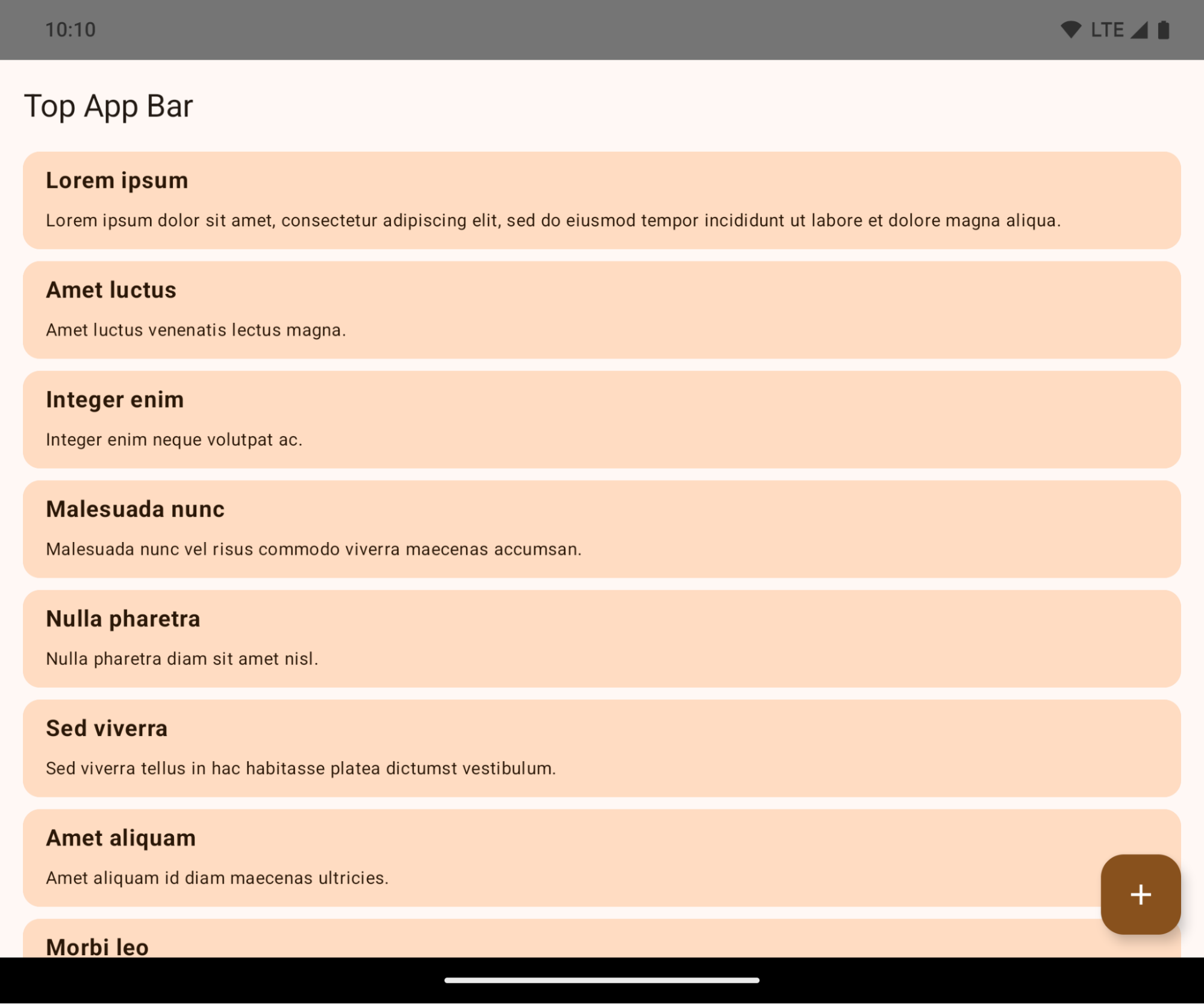
Это критическое изменение, которое может негативно повлиять на пользовательский интерфейс вашего приложения. Изменения затрагивают следующие области пользовательского интерфейса:
- Панель навигации с помощью жестов
- Прозрачный по умолчанию.
- Смещение вниз отключено, поэтому содержимое отображается за панелью навигации системы, если не применены вставки.
-
setNavigationBarColorиR.attr#navigationBarColorустарели и не влияют на навигацию с помощью жестов. -
setNavigationBarContrastEnforcedиR.attr#navigationBarContrastEnforcedпо-прежнему не оказывают влияния на навигацию с помощью жестов.
- 3-кнопочная навигация
- Непрозрачность по умолчанию установлена на 80%, цвет может совпадать с цветом фона окна.
- Смещение снизу отключено, поэтому содержимое отображается за панелью навигации системы, если не применены вставки.
-
setNavigationBarColorиR.attr#navigationBarColorпо умолчанию задаются в соответствии с фоном окна. Для применения этого значения по умолчанию фон окна должен быть цветным. Этот API устарел, но по-прежнему влияет на навигацию с помощью трёх кнопок. -
setNavigationBarContrastEnforcedиR.attr#navigationBarContrastEnforcedпо умолчанию имеют значение true, что добавляет 80% непрозрачный фон для 3-кнопочной навигации.
- Строка состояния
- Прозрачный по умолчанию.
- Верхнее смещение отключено, поэтому содержимое отображается за строкой состояния, если не применены вставки.
-
setStatusBarColorиR.attr#statusBarColorустарели и не действуют в Android 15. -
setStatusBarContrastEnforcedиR.attr#statusBarContrastEnforcedустарели, но все еще действуют в Android 15.
- Вырез дисплея
-
layoutInDisplayCutoutModeнеплавающих окон должно бытьLAYOUT_IN_DISPLAY_CUTOUT_MODE_ALWAYS.SHORT_EDGES,NEVERиDEFAULTинтерпретируются какALWAYS, чтобы пользователи не видели черную полосу, вызванную вырезом на дисплее, и чтобы окно отображалось от края до края.
-
В следующем примере показано приложение до и после перехода на Android 15 (уровень API 35), а также до и после применения вставок. Этот пример не является исчерпывающим, в Android Auto это может выглядеть иначе.
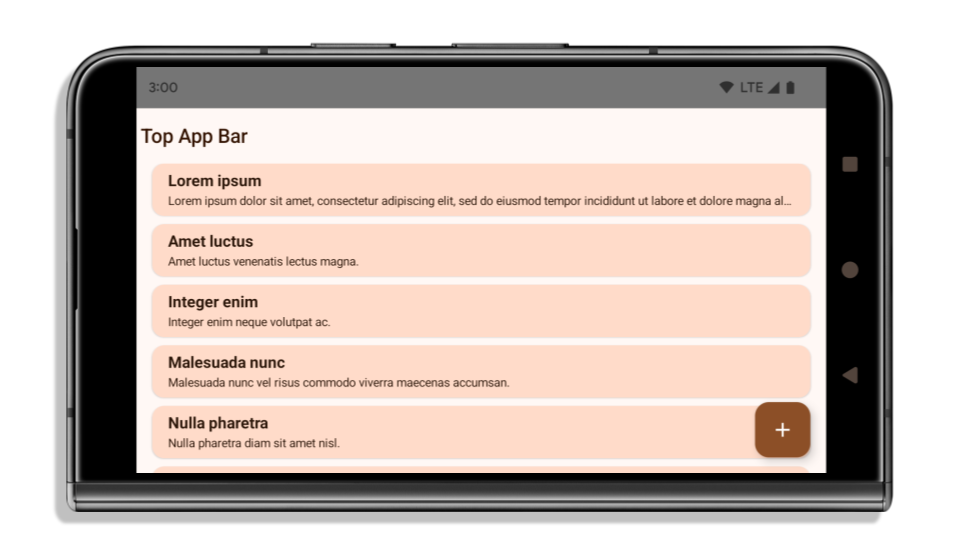
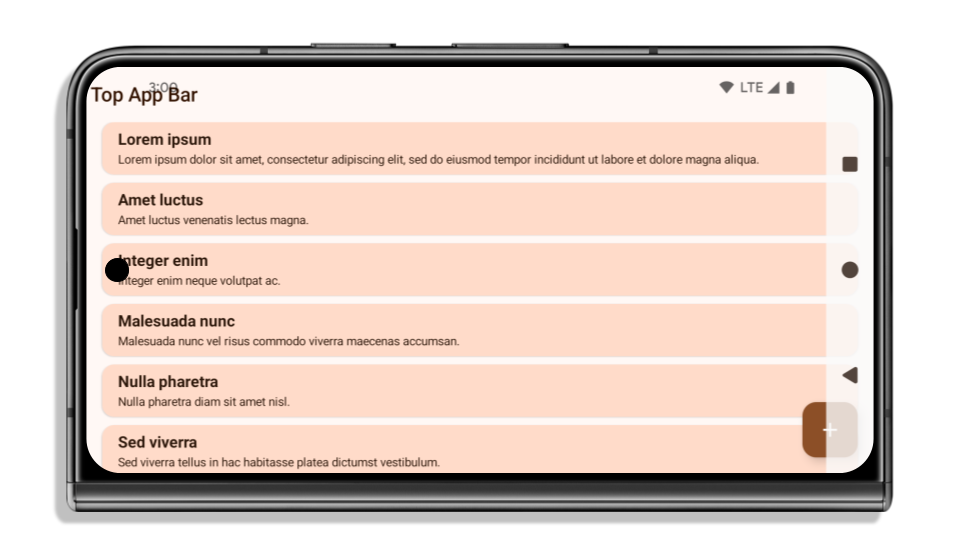

Что нужно проверить, если ваше приложение уже развернуто на всех устройствах
Если ваше приложение уже развернуто от края до края и использует вставки, то, как правило, это не повлияет на вас, за исключением следующих случаев. Однако, даже если вы считаете, что это не повлияет, мы рекомендуем вам протестировать приложение.
- У вас есть неплавающее окно, например
Activity, которое используетSHORT_EDGES,NEVERилиDEFAULTвместоLAYOUT_IN_DISPLAY_CUTOUT_MODE_ALWAYS. Если ваше приложение вылетает при запуске, это может быть связано с заставкой. Вы можете обновить основную зависимость заставки до 1.2.0-alpha01 или более поздней, либо установитьwindow.attributes.layoutInDisplayCutoutMode = WindowManager.LayoutInDisplayCutoutMode.always. - Возможно, есть экраны с низкой посещаемостью и перекрытым пользовательским интерфейсом. Убедитесь, что на этих экранах с низкой посещаемостью пользовательский интерфейс не перекрыт. К экранам с низкой посещаемостью относятся:
- Экраны регистрации и входа в систему
- Страницы настроек
Что проверить, если ваше приложение еще не является полноэкранным
Если ваше приложение ещё не является полноэкранным, скорее всего, вы пострадаете. Помимо сценариев для полноэкранных приложений, вам следует учесть следующее:
- Если ваше приложение использует компоненты Material 3 (
androidx.compose.material3) в компоновке, такие какTopAppBar,BottomAppBarиNavigationBar, эти компоненты, скорее всего, не будут затронуты, поскольку они автоматически обрабатывают вставки. - Если ваше приложение использует компоненты Material 2 (
androidx.compose.material) в Compose, эти компоненты не обрабатывают вставки автоматически. Однако вы можете получить к ним доступ и применить их вручную. В androidx.compose.material 1.6.0 и более поздних версиях используйте параметрwindowInsets, чтобы вручную применить вставки дляBottomAppBar,TopAppBar,BottomNavigationиNavigationRail. Аналогично, используйте параметрcontentWindowInsetsдляScaffold. - Если ваше приложение использует представления и компоненты Material (
com.google.android.material), большинство компонентов Material, основанных на представлениях, таких какBottomNavigationView,BottomAppBar,NavigationRailViewилиNavigationView, обрабатывают вставки и не требуют дополнительных действий. Однако при использованииAppBarLayoutнеобходимо добавитьandroid:fitsSystemWindows="true". - Для пользовательских компонуемых элементов отступы можно задать вручную в качестве отступов. Если ваш контент находится в
Scaffold, вы можете использовать отступы, используя значения отступовScaffold. В противном случае отступы можно задать с помощью одного изWindowInsets. - Если ваше приложение использует представления и
BottomSheet,SideSheetили пользовательские контейнеры, задайте отступы с помощьюViewCompat.setOnApplyWindowInsetsListener. ДляRecyclerViewзадайте отступы с помощью этого прослушивателя, а также добавьтеclipToPadding="false".
Что нужно проверить, если ваше приложение должно предлагать настраиваемую фоновую защиту
Если ваше приложение должно предлагать настраиваемую защиту фона для 3-кнопочной навигации или строки состояния, ваше приложение должно разместить компонуемый элемент или представление за системной панелью, используя WindowInsets.Type#tappableElement() для получения высоты 3-кнопочной панели навигации или WindowInsets.Type#statusBars .
Дополнительные ресурсы Edge-to-Edge
Дополнительную информацию о применении вставок см. в руководствах Edge to Edge Views и Edge to Edge Compose .
Устаревшие API
Следующие API устарели, но не отключены:
-
R.attr#enforceStatusBarContrast -
R.attr#navigationBarColor(для навигации с тремя кнопками, с альфа-каналом 80%) -
Window#isStatusBarContrastEnforced -
Window#setNavigationBarColor(для навигации с 3 кнопками, с альфа-каналом 80%) -
Window#setStatusBarContrastEnforced
Следующие API устарели и отключены:
-
R.attr#navigationBarColor(для навигации жестами) -
R.attr#navigationBarDividerColor -
R.attr#statusBarColor -
Window#setDecorFitsSystemWindows -
Window#getNavigationBarColor -
Window#getNavigationBarDividerColor -
Window#getStatusBarColor -
Window#setNavigationBarColor(для навигации жестами) -
Window#setNavigationBarDividerColor -
Window#setStatusBarColor
Стабильная конфигурация
Если ваше приложение предназначено для Android 15 (уровень API 35) или выше, Configuration больше не исключает системные панели. Если вы используете размер экрана в классе Configuration для расчёта макета, замените его более подходящими альтернативами, такими как ViewGroup , WindowInsets или WindowMetricsCalculator , в зависимости от ваших потребностей.
Configuration доступна с версии API 1. Обычно её можно получить из Activity.onConfigurationChanged . Она предоставляет такую информацию, как плотность, ориентация и размеры окна. Важной особенностью размеров окна, возвращаемых функцией Configuration является то, что ранее она не включала системные панели.
Размер конфигурации обычно используется для выбора ресурсов, например, /res/layout-h500dp , и это всё ещё допустимый вариант использования. Однако использование его для расчёта макета всегда не рекомендовалось. Если вы всё же решили так поступить, вам следует отказаться от него сейчас. Вам следует заменить использование Configuration на что-то более подходящее в зависимости от вашего варианта использования.
Если вы используете его для расчета макета, используйте соответствующую ViewGroup , например CoordinatorLayout или ConstraintLayout . Если вы используете его для определения высоты системной панели навигации, используйте WindowInsets . Если вы хотите узнать текущий размер окна приложения, используйте computeCurrentWindowMetrics .
В следующем списке описываются поля, затронутые этим изменением:
- Размеры
Configuration.screenWidthDpиscreenHeightDpбольше не исключают системные панели. -
Configuration.smallestScreenWidthDpкосвенно влияют измененияscreenWidthDpиscreenHeightDp. -
Configuration.orientationкосвенно влияют измененияscreenWidthDpиscreenHeightDpна устройствах с экранами, близкими к квадратным. - Изменения в
Configurationкосвенно затрагиваютDisplay.getSize(Point). Этот метод устарел, начиная с API уровня 30. -
Display.getMetrics()работает таким образом, начиная с API уровня 33.
Атрибут elegantTextHeight по умолчанию имеет значение true
Для приложений, ориентированных на Android 15 (уровень API 35), атрибут elegantTextHeight TextView становится true по умолчанию, заменяя компактный шрифт, используемый по умолчанию, некоторыми скриптами с большими вертикальными метриками на гораздо более читаемый. Компактный шрифт был введен, чтобы предотвратить нарушение макета; Android 13 (уровень API 33) предотвращает многие из этих проблем, позволяя текстовому макету растягивать вертикальную высоту с помощью атрибута fallbackLineSpacing .
В Android 15 компактный шрифт по-прежнему остается в системе, поэтому ваше приложение может установить для elegantTextHeight значение false чтобы получить то же поведение, что и раньше, но вряд ли он будет поддерживаться в следующих выпусках. Итак, если ваше приложение поддерживает следующие сценарии: арабский, лаосский, мьянманский, тамильский, гуджаратский, каннада, малаялам, одиа, телугу или тайский, протестируйте свое приложение, установив для elegantTextHeight значение true .

elegantTextHeight для приложений, ориентированных на Android 14 (уровень API 34) и ниже. 
elegantTextHeight для приложений, ориентированных на Android 15.Изменение ширины TextView для сложных форм букв
В предыдущих версиях Android некоторые рукописные шрифты или языки сложной формы могли отображать буквы в области предыдущего или следующего символа. В некоторых случаях такие буквы обрезались в начальной или конечной позиции. Начиная с Android 15, TextView выделяет ширину для рисования достаточного места для таких букв и позволяет приложениям запрашивать дополнительные поля слева, чтобы предотвратить обрезку.
Поскольку это изменение влияет на то, как TextView определяет ширину, TextView по умолчанию выделяет большую ширину, если приложение предназначено для Android 15 (уровень API 35) или выше. Вы можете включить или отключить это поведение, вызвав API setUseBoundsForWidth в TextView .
Поскольку добавление левого отступа может привести к смещению существующих макетов, отступы не добавляются по умолчанию даже для приложений, ориентированных на Android 15 или более позднюю версию. Однако вы можете добавить дополнительные отступы для предотвращения обрезки, вызвав setShiftDrawingOffsetForStartOverhang .
В следующих примерах показано, как эти изменения могут улучшить макет текста для некоторых шрифтов и языков.
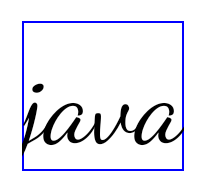
<TextView android:fontFamily="cursive" android:text="java" />
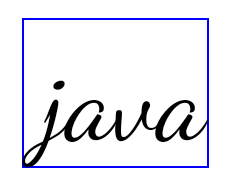
<TextView android:fontFamily="cursive" android:text="java" android:useBoundsForWidth="true" android:shiftDrawingOffsetForStartOverhang="true" />

<TextView android:text="คอมพิวเตอร์" />

<TextView android:text="คอมพิวเตอร์" android:useBoundsForWidth="true" android:shiftDrawingOffsetForStartOverhang="true" />
Высота строки по умолчанию для EditText с учетом локали
В предыдущих версиях Android текстовый макет растягивал высоту текста так, чтобы она соответствовала высоте строки шрифта, соответствующего текущему языковому стандарту. Например, если контент был на японском языке, поскольку высота строки японского шрифта немного больше, чем у латинского шрифта, высота текста стала немного больше. Однако, несмотря на эти различия в высоте строк, размер элемента EditText был одинаковым, независимо от используемой локали, как показано на следующем изображении:

EditText , которые могут содержать текст на английском (en), японском (ja) и бирманском (my). Высота EditText одинакова, хотя эти языки имеют разную высоту строк. Для приложений, ориентированных на Android 15 (уровень API 35), минимальная высота строки теперь зарезервирована для EditText , чтобы соответствовать эталонному шрифту для указанного языкового стандарта, как показано на следующем изображении:

EditText , которые могут содержать текст на английском (en), японском (ja) и бирманском (my). Высота EditText теперь включает пространство для размещения высоты строки по умолчанию для шрифтов этих языков. При необходимости ваше приложение может восстановить предыдущее поведение, указав для атрибута useLocalePreferredLineHeightForMinimum значение false , а ваше приложение может установить собственные минимальные вертикальные метрики с помощью API setMinimumFontMetrics в Kotlin и Java.
Камера и медиа
Android 15 вносит следующие изменения в поведение камеры и мультимедиа для приложений, предназначенных для Android 15 или более поздних версий.
Ограничения на запрос аудиофокуса
Приложения, предназначенные для Android 15 (уровень API 35), должны быть главным приложением или запускать службу переднего плана, чтобы запросить фокус звука . Если приложение пытается запросить фокус, хотя оно не соответствует одному из этих требований, вызов возвращает AUDIOFOCUS_REQUEST_FAILED .
Дополнительную информацию о фокусе звука можно узнать в разделе «Управление фокусом звука» .
Обновлены ограничения, не связанные с SDK
В Android 15 включены обновлённые списки ограниченных интерфейсов, не входящих в SDK, основанные на результатах сотрудничества с разработчиками Android и последних внутренних тестов. По возможности мы проверяем наличие общедоступных альтернатив, прежде чем ограничивать интерфейсы, не входящие в SDK.
Если ваше приложение не предназначено для Android 15, некоторые из этих изменений могут не сразу вас затронуть. Однако, хотя ваше приложение может обращаться к некоторым интерфейсам, не относящимся к SDK , в зависимости от целевого уровня API , использование любого метода или поля, не относящегося к SDK, всегда несёт высокий риск выхода приложения из строя.
Если вы не уверены, использует ли ваше приложение интерфейсы, не относящиеся к SDK, вы можете протестировать его , чтобы выяснить это. Если ваше приложение использует интерфейсы, не относящиеся к SDK, вам следует начать планировать миграцию на альтернативы SDK. Тем не менее, мы понимаем, что в некоторых приложениях есть обоснованные примеры использования интерфейсов, не относящихся к SDK. Если вы не можете найти альтернативу использованию интерфейса, не относящегося к SDK, для какой-либо функции вашего приложения, вам следует запросить новый публичный API .
Дополнительные сведения об изменениях в этой версии Android см. в разделе Обновления ограничений интерфейса, не связанных с SDK, в Android 15 . Дополнительные сведения об интерфейсах, отличных от SDK, см. в разделе Ограничения на интерфейсы, не относящиеся к SDK .

